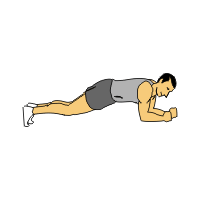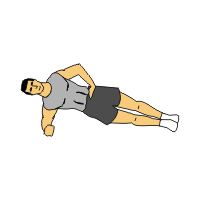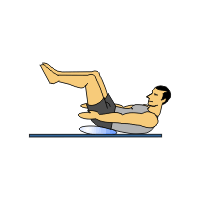Isometric exercises, also known as static strength training, involve muscular actions in which the length of the muscle does not change and there is no visible movement at the joint (1).
The term 'static contraction training' is sometimes used to describe isometrics. However, 'contraction' signifies a change in length (shortening) of the muscle belly, which does not occur during static strength training. The term 'static action' is preferred to static contraction.
Isometric exercises can be used for general strength conditioning and for rehabilitation where strengthening the muscles without placing undue stress on the joint is warranted.
Some actions within a wide variety of sports require isometric or static strength. Examples include climbing, mountain biking and motocross (grip and upper body strength), Judo, wrestling, alpine skiing (static strength required to stabilize the upper and lower body), shooting, gymnastics and horseback riding.
Isometric exercises can be completed with submaximal muscle action - such as holding a weight steady, out to the side. The force used to hold the weight still is not maximal as this would lift the weight further causing movement and a change in the muscle length and joint angle. Static strength training can also involve maximal muscle actions and examples here include pushing against an immoveable object such as a wall or heavy weight.
Both submaximal and maximal isometric muscle actions can increase isometric strength (2,3,4) and induce muscular hypertrophy (5,6). In practice, maximal isometric exercises are used for strength and conditioning and submaximal exercises are used for rehabilitation (1).
Although isometric exercises can increase strength they are not the most suitable form of resistance training for dynamic actions such as sprinting and jumping. Most sports and athletic movements are dynamic in nature, performed at maximal speed against little or no external resistance. Isometric exercises do not increase the limb's maximal velocity and only strengthen the muscle at the angle at which it is trained (see below).
Guidelines For Isometric Exercises
Isometric exercises can raise blood pressure significantly for the duration of the exercise. While it will return to a resting level soon after, this can be dangerous for people with hypertension or any form of cardiovascular disease. Even if you don't suffer from high blood pressure it is important to breathcontinuously throughout the exercises. Breath holding will only compound any increases in blood pressure.
As with all forms of exercise you should warm up thoroughly first. Muscles are under tension for a longer period of time and although that tension is more constant compared to a dynamic contraction, tears can still occur. Finally, try to maintain some degree of tension in the abdominal region during all exercises. This will help to maintain a correct posture and will help to develop core stability.
Number & Duration of Muscle Actions
Volume for a classic strength training routine is prescribed based on the number of sets and repetitions. The equivalent in isometric exercises is the length of time each action is held for and the number actions in total. Research has measured both longer duration actions (i.e. 10 seconds or above) and fewer repetitions, and shorter duration actions (i.e. 2-3 seconds) with more repetitions (6,7,8). Both approaches seem to increase static strength.
Volume for a classic strength training routine is prescribed based on the number of sets and repetitions. The equivalent in isometric exercises is the length of time each action is held for and the number actions in total. Research has measured both longer duration actions (i.e. 10 seconds or above) and fewer repetitions, and shorter duration actions (i.e. 2-3 seconds) with more repetitions (6,7,8). Both approaches seem to increase static strength.
The general consensus is that in healthy individuals training to improve strength (as opposed to rehabilitation of an injury), the most efficient use of isometric exercises is 15-20 maximal voluntary actions held for 3 to 5 seconds (1). Three sessions per week is required (2) and results can be seen in as little as 2 weeks. However, when submaximal loads are used (such as bodyweight) it may be more suitable to increase the duration and reduce the number of repetitions.
This number and duration of contractions is required for each muscle group. As with traditional dynamic strength training, exercise selection should be based on a needs analysis of the athlete. Multi joint isometric exercises such as static leg presses may be more suitable then isolating the quadriceps, hamstrings and other hip flexors / extensors.
Joint Angles
Isometric exercises strengthen the muscle at or near to the joint angle at which the exercise is performed. For example a static bicep exercise held with the joint at 25o only increases the athlete's strength at that specific angle (9) and there is no gain in strength when the elbow is held at other angles. However, at particular joint angles (and it varies from muscle group to muscle group) there is some cross-transference of strength to other joint angles. An isometric bicep curl performed at 80o for example also increases strength at other angles to a lesser extent (9). The same phenomenon is true for the knee (10) and plantar flexors (5).
Isometric exercises strengthen the muscle at or near to the joint angle at which the exercise is performed. For example a static bicep exercise held with the joint at 25o only increases the athlete's strength at that specific angle (9) and there is no gain in strength when the elbow is held at other angles. However, at particular joint angles (and it varies from muscle group to muscle group) there is some cross-transference of strength to other joint angles. An isometric bicep curl performed at 80o for example also increases strength at other angles to a lesser extent (9). The same phenomenon is true for the knee (10) and plantar flexors (5).
Essentially, training at only one joint angle does not increase strength throughout the full range of motion (1). In order to improve dynamic power, isometric exercises would have to be performed at multiple joint angles for the same muscle group. This becomes time consuming and enervating for an athlete who may already be spending considerable time on other training modalities.
If static strength training is used to increase strength throughout the entire range of motion, isometric exercises should be performed at every 10 to 30 degree increments. If this is too time consuming, it is better to perform exercises at an extended joint angle (rather than a flexed joint angle) as this leads to greater cross-transference of strength at other angles (1).
Example Full Body Isometric Exercises
The following isometric exercises use submaximal contractions i.e. bodyweight or a light free weights.
 Plank Bridge
Plank Bridge1. Start by lying face down on the ground. Place your elbows and forearms underneath your chest.
2. Prop yourself up to form a bridge using your toes and forearms.
3. Maintain a flat back and do not allow your hips to sag towards the ground.
4. Hold for 10-30 seconds or until you can no longer maintain a flat bridge. Repeat 2-3 times.

Side Bridge
1.Start on your side and press up with your right arm.
2.Form a bridge with your arm extended and hold for 10-30 seconds. Repeat 2-3 times.

Hundred Breaths Exercise
This isometric exercise is taken from Pilates and is excellent for developing static strength in the core region.
1. Lie face up on a mat with arms by your sides. Bend legs to 90 degrees. Lift your head and shoulders off mat and take 5 short, consecutive inhales, followed by 5 short, consecutive exhales.
2. At the same time, lift arms off mat and pulse them in unison with the breath � palms face up on inhale and down on exhale.
3. Repeat 10 times for a total of 100 breaths.
2. At the same time, lift arms off mat and pulse them in unison with the breath � palms face up on inhale and down on exhale.
3. Repeat 10 times for a total of 100 breaths.
Example Upper & Lower Body Isometric Exercises
Isometric Push Ups
1. Starting in the push up position with arms fully extended, lower yourself to about half way to the floor.
2. Hold this position for 10-30 seconds remembering to breathe. Repeat 2-3 times.
1. Starting in the push up position with arms fully extended, lower yourself to about half way to the floor.
2. Hold this position for 10-30 seconds remembering to breathe. Repeat 2-3 times.
Isometric Shoulder Raises
1. Standing with feet shoulder width apart raise a dumbbell (or light weight) directly out to your side.
2. When your arm is parallel to the ground hold for 10-30 seconds or until your arm begins to drop.
3. Repeat 2-3 times and change arms. Alternatively you can work both arms at once, which can be a little better for posture.
1. Standing with feet shoulder width apart raise a dumbbell (or light weight) directly out to your side.
2. When your arm is parallel to the ground hold for 10-30 seconds or until your arm begins to drop.
3. Repeat 2-3 times and change arms. Alternatively you can work both arms at once, which can be a little better for posture.
Isometric Squats
1. Place your back against a wall and lower yourself until your upper legs are parallel to the floor
2. Shuffle your feet until your lower legs are parallel to the wall behind you. Your knees should be bent to 90 degrees.
3. Hold your arms out in front of you and hold the position for 10-30 seconds. Repeat 2-3 times.
1. Place your back against a wall and lower yourself until your upper legs are parallel to the floor
2. Shuffle your feet until your lower legs are parallel to the wall behind you. Your knees should be bent to 90 degrees.
3. Hold your arms out in front of you and hold the position for 10-30 seconds. Repeat 2-3 times.
Isometric Calf Raises
1. Standing next to a sturdy chair (or any fixed objective) stand on just your right leg.
2. Rest your left foot on the back of your right calf and stand up on to your toes holding on to the chair for balance.
3. Hold the position for 10-30 seconds and repeat 2-3 times. Now repeat for the left leg.
1. Standing next to a sturdy chair (or any fixed objective) stand on just your right leg.
2. Rest your left foot on the back of your right calf and stand up on to your toes holding on to the chair for balance.
3. Hold the position for 10-30 seconds and repeat 2-3 times. Now repeat for the left leg.
Isometric Leg Extensions
1. Stand next to a bed (should be about 18 inches high). You should be facing away from the bed with the backs of your legs against the side of the bed.
2. Bend your right leg and rest it on the bed behind you. Your upper leg should be pointing straight down and your knee bent to roughly 90 degrees with your lower leg resting on the bed parallel to the floor.
3. Push your right leg into the bed as forcefully as possible and hold for 10-30 seconds.
4. Repeat 2-3 times and change legs. Remember to breathe!
1. Stand next to a bed (should be about 18 inches high). You should be facing away from the bed with the backs of your legs against the side of the bed.
2. Bend your right leg and rest it on the bed behind you. Your upper leg should be pointing straight down and your knee bent to roughly 90 degrees with your lower leg resting on the bed parallel to the floor.
3. Push your right leg into the bed as forcefully as possible and hold for 10-30 seconds.
4. Repeat 2-3 times and change legs. Remember to breathe!
Isometric Hip Extensions
1. Stand next to a table or sturdy chair for support. You should be facing towards the table.
2. Raise your right leg directly behind you keeping it as straight as possible as you hold onto the table in front of your for balance.
3. You will need to bend forward slightly at the waist and also bend your standing, left leg slightly to take the strain off your left hamstrings.
4. Try to get your leg parallel to the ground. You should feel your right hamstrings, glutes and lower back contracting.
5. Hold for 10-30 seconds, repeat 2-3 times and change legs. Remember to breathe!
1. Stand next to a table or sturdy chair for support. You should be facing towards the table.
2. Raise your right leg directly behind you keeping it as straight as possible as you hold onto the table in front of your for balance.
3. You will need to bend forward slightly at the waist and also bend your standing, left leg slightly to take the strain off your left hamstrings.
4. Try to get your leg parallel to the ground. You should feel your right hamstrings, glutes and lower back contracting.
5. Hold for 10-30 seconds, repeat 2-3 times and change legs. Remember to breathe!
Isometric Hip Abductions
1. Stand to the side of a sturdy chair or table for support. Your left leg should be next to the back of the chair.
2. Holding on to the chair with your left arm only, raise your right leg directly out to the side as high as you can.
3. Hold your leg as close to parallel to the floor as your can and keep that position for 10-30 seconds.
4. Repeat 2-3 times and change legs.
1. Stand to the side of a sturdy chair or table for support. Your left leg should be next to the back of the chair.
2. Holding on to the chair with your left arm only, raise your right leg directly out to the side as high as you can.
3. Hold your leg as close to parallel to the floor as your can and keep that position for 10-30 seconds.
4. Repeat 2-3 times and change legs.
Source
Comments: If you have been injured or are not fit then you need to do these exercises first. Just because you are not moving does not mean you are not working. These exercises will condition your body to work again without putting too much strain on your joints.
Comments: If you have been injured or are not fit then you need to do these exercises first. Just because you are not moving does not mean you are not working. These exercises will condition your body to work again without putting too much strain on your joints.
No comments:
Post a Comment